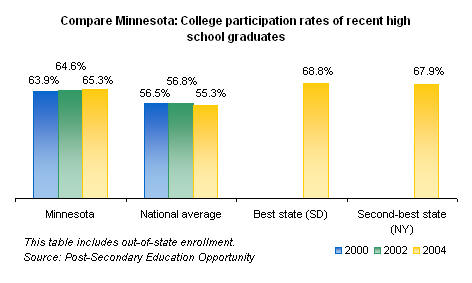 |
DEPARTMENT
RESULTS |
|
|
|
PLEASE NOTE: The Office of Higher Education is working
with policymakers and stakeholders to establish specific targets on many
performance indicators. The state continually aims for Minnesota’s higher
education students to perform at nation-leading and world-leading levels.
Comparisons to other states and countries are provided on some of the
following indicators.
|
|
Goal:
To develop and maintain an accountability system that will gauge the higher
education sector's effectiveness and progress in meeting state goals |
|
Why is this goal important?
Minnesota has a strong higher education sector with many choices available
to students. However other states and countries are taking aggressive steps
to prepare their citizens for the future and Minnesota must be poised to
compete. Minnesota needs a measurement system to improve the education
results of the sector and inform policy makers of changes required to be
successful in a global environment.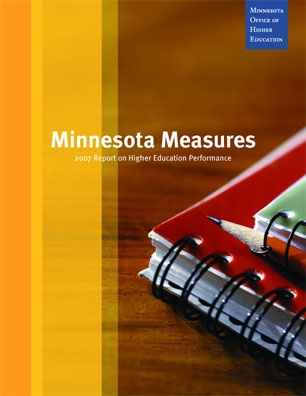
How will this goal be accomplished?
Governor Tim Pawlenty assigned the development of an accountability system
to the Office of Higher Education. Together the Governor and Legislature
appropriated money to the agency. The Office of Higher Education engaged the
National Center for Higher education Management Systems to assist in the
initial development of the project by drawing upon the experiences of other
states to develop indicators.
Statewide and regional
meetings were held in 2005 and 2006 to gather input from all stakeholders.
The initial report, called
Minnesota Measures was issued
in January 2007.
The agency will publish a comprehensive annual report and interim updates.
The current report includes five goals and 18 indicators.
How will progress be achieved?
The Minnesota Measures report will be issued annually. Benchmarks will be
added in 2007 and progress toward the benchmarks will be gauged and
reported. The indicators in the report will be expanded and refined, and
updates will be made online.
|
|
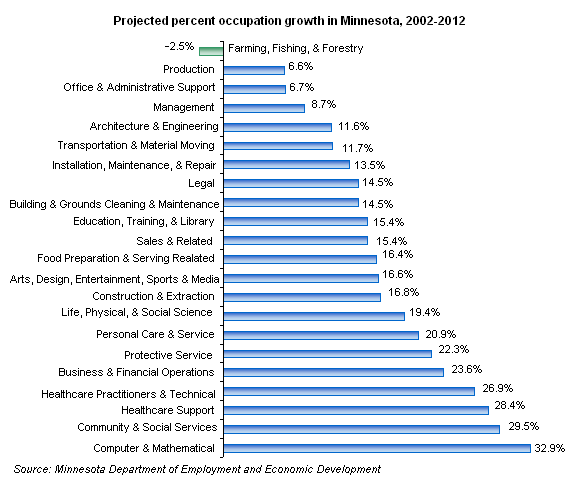 |
|
Goal:
To create a responsive system of higher education that produces graduates at
all levels who will meet the demands of the economy |
|
Why is this goal important?
Technology is
driving dramatic changes in consumer products, business processes and
 economic competition. The higher education sector
must be equally
responsive
to the demands of consumers of its services, including employers, students
and citizens. The U.S. Department of Labor reports that two-thirds of all
new future jobs will require some level of postsecondary education.
Minnesota is producing too few graduates at both the associate and baccalaureate levels in high-demand fields. The share of degrees produced in
the science and engineering fields is below the national average. Minnesota
has relied heavily in the past on in-migration of talent to meet its
workforce needs. To compete effectively, Minnesota must create greater
alignment between its higher education offerings and its economic potential. economic competition. The higher education sector
must be equally
responsive
to the demands of consumers of its services, including employers, students
and citizens. The U.S. Department of Labor reports that two-thirds of all
new future jobs will require some level of postsecondary education.
Minnesota is producing too few graduates at both the associate and baccalaureate levels in high-demand fields. The share of degrees produced in
the science and engineering fields is below the national average. Minnesota
has relied heavily in the past on in-migration of talent to meet its
workforce needs. To compete effectively, Minnesota must create greater
alignment between its higher education offerings and its economic potential.
|
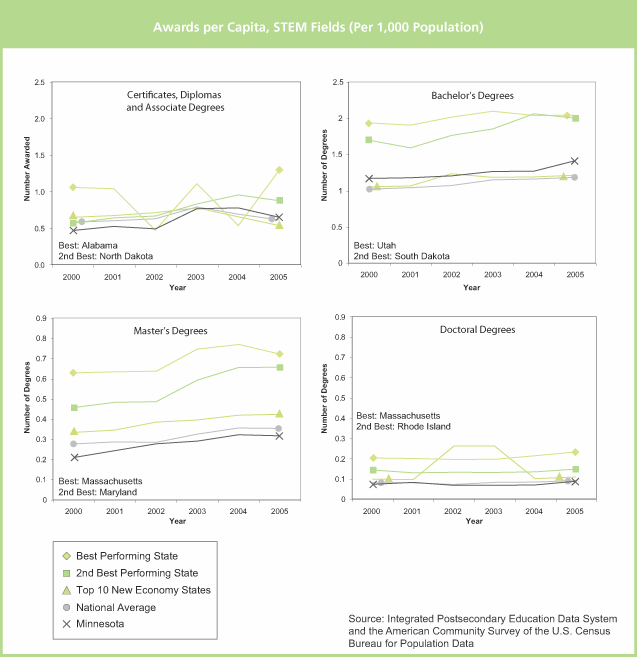 |
How will this goal be achieved?
The state’s new accountability system for higher education includes a number
of measures of graduation rates for postsecondary institutions in the state.
The transparency added by these measures will highlight the need to increase
degree production, particularly in certain STEM fields. A number of policy
changes may also be suggested.
 In 2005, the Governor
and Legislature took two important steps to create centers of excellence at
Minnesota’s public universities. The Governor proposed the creation of a new
campus of the University of Minnesota located in Rochester, Minnesota, that
will leverage partnerships with the two industry giants, the Mayo Clinic and
IBM. The new university will adopt a biotech and information technology
focus and develop unique programs in genomics, bioinformatics, and
information technology and related fields. In 2005, the Governor
and Legislature took two important steps to create centers of excellence at
Minnesota’s public universities. The Governor proposed the creation of a new
campus of the University of Minnesota located in Rochester, Minnesota, that
will leverage partnerships with the two industry giants, the Mayo Clinic and
IBM. The new university will adopt a biotech and information technology
focus and develop unique programs in genomics, bioinformatics, and
information technology and related fields.
The Governor’s proposal
to create additional centers of excellence at regional comprehensive
universities also shows signs of promise, with centers emerging in
manufacturing technology, allied health and information technology and
security. Each is expected to build expertise, partnerships, unique
flagship programs and enrollment over the next several years.
The K-12 system is
working in collaboration with higher education partners to increase the
awareness of the need for more graduates in the science, technology
engineering and mathematics fields. A grant from the National Governors
Association has supported many of these efforts.
How will progress be measured?
The Office of Higher Education will review the current indicators in this
area and suggest improvements and set benchmarks, or targets. These will be
reported annually to the Governor and the Legislature. |
|
|
|
Goal:
To
improve success of all students in higher education, particularly students
from groups traditionally underrepresented in higher education |
|
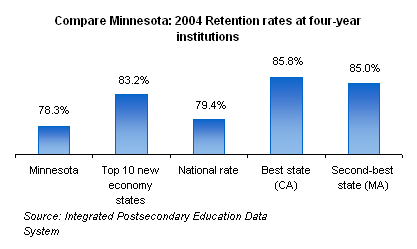 Why is this goal important? Why is this goal important?
Success in education is the primary goal for all students. It is in the
state’s best interest that every citizen reach his or her full potential.
For Minnesota to compete globally, every citizen must reach his or her full
potential. As demographics change and a
growing number of living-wage jobs require some higher education, Minnesota
has a keen interest in
seeing more students achieve success in postsecondary education.
Retention, graduation rates, educational
attainment are all measures of student success.
First- to second-year retention at Minnesota’s four-year colleges is
slightly below the national average.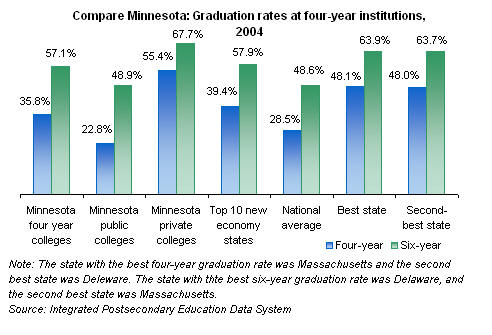
Graduation rates leave room for
improvement. The four-year graduation rate was 22.8 percent at Minnesota’s
public colleges and universities and 55.4 percent at the state’s private
colleges. The six year graduation rate was 48.9 percent and 67 percent
respectively.
How will this goal be achieved?
The first step to achieving this goal is to measure progress toward it.
With this measurement system in place, state benchmarks will be set in 2007
for policymakers and the public to review. Many initiatives are in place to
address student success. Governor Pawlenty’s high school initiative and the
ACHIEVE Scholarship program are both aimed at helping high school students
become better prepared for, and successful in, college.
How will progress be measured?
The Office of Higher Education will continue to add indicators and refine
existing indicators that demonstrate student success. Benchmarks will be
established and regular reporting will occur.
|
|
Goal:
To improve higher education access, affordability and choice for all
students |
|
Why is this goal important?
A critical role of the higher education sector is the alignment of
individual interest and abilities with the economic demands of the market
and workplace. This alignment occurs when students have access and choice.
When students are limited in their choices of academic programs and
institutions, the market is not served well and students may not find the
best educational fit. Student access and choice can influence whether
students find the right educational “fit” on the first try.
How will this goal be achieved?
The Minnesota State Grant program
is among the largest need-based grant
programs in the nation.
Diligence must be exercised to ensure that changes
in enrollment and increases in price are reflected in the program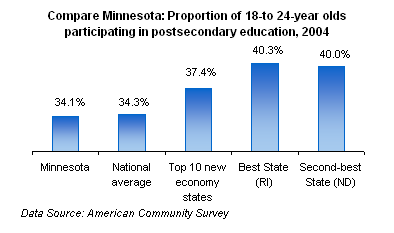 parameters. Net college prices remain a concern for students from families
with the lowest income levels. Middle-income families pay the highest share
of their income on higher education. The Office of
Higher Education must continue to identify new measures of choice and access
and provide this information
to policymakers.
parameters. Net college prices remain a concern for students from families
with the lowest income levels. Middle-income families pay the highest share
of their income on higher education. The Office of
Higher Education must continue to identify new measures of choice and access
and provide this information
to policymakers.
The percent of 18 to 24-year-olds in college in Minnesota is well below the
national average.
|
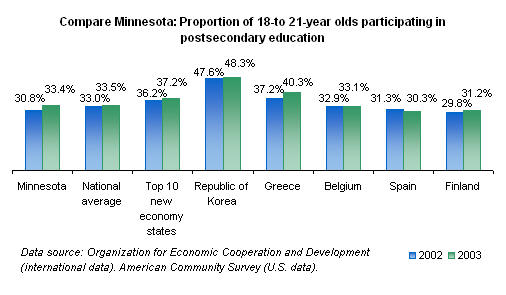
|
Participation rates indicate what
percentage of a high school graduating class continue directly into higher
education. In Minnesota, 65 percent of the class of 2004 enrolled in college
in Minnesota or elsewhere. While this is above the national average, about
23,000 graduates are still not choosing to continue on to college. In
addition, other countries are stepping up efforts to increase their
college-going rates.
How will progress be measured?
College participation as an indicator of access and affordability will
continue to be measured in these and different ways. Benchmarks will be
established.
|
|
Goal:
To provide students, prospective students, parents and others with
information and resources to help students pay for college |
|
 Why is this goal important? Why is this goal important?
Exploring and applying to college is not something students do on a regular
basis. Because the process has many steps, and programs and procedures are
constantly changing, even the most experienced students and families need
guidance. Minnesota is best served when its citizens clearly understand the
benefits of higher education and how to access the offerings of colleges and
universities for themselves and their children.
How will this goal be achieved?
In 2003, Governor Pawlenty established the Minnesota Office of Higher
Education as a cabinet-level state agency. The agency’s director is
appointed by the Governor, and one of the agency’s important charges in
statute is to provide information to prospective students about their
college options and financial aid. The Office of Higher Education
administers several programs to help students save for and pay for college.
The agency publishes a Minnesota College Guide and a Guide to Paying for
College. It also maintains an informational Web site for students (www.getreadyforcollege.org).
In FY 2007, the Office of Higher
Education invited the entire higher education sector to collaborate on an
outreach initiative for middle school students to help them understand that
the choices they make now about school will have long term implications on
their lives. The Make it Happen campaign receives financial support from the
University of Minnesota, the Minnesota State Colleges and Universities, the
Minnesota Private Colleges, the Minnesota Career College Association, the
Department of Education and the Office of Higher Education. The Minnesota
Minority Education Partnership and the Minnesota Campus Compact are also
partners on the initiative.
How will progress be measured?
The agency measures Web activity and requests for materials. The campaign
includes a TV spot, out-of-home print advertising and a Web site, targeted
to low-income students in grades seven through nine. The Web site is
www.imakeithappen.org.
The agency and its staff made
approximately 75 presentations in FY 2007, primarily informing students and
parents about their college options and financial aid.
In 2006, the agency's
Web sites registered the following hits:
Publications sent out
upon request:
-
Your Guide to
Paying for College: 105,000 Copies
-
A Student’s
Introduction to Paying for College (in four languages): 50,000
copies
-
Minnesota
College Guide: 55,000 copies
The agency also has
strong relationships with financial aid administrators, high school
counselors and public and private colleges and universities in general.
|
| |
|
Some images © 2003 www.clipart.com |
|
Last update on
11/20/2007
|
|





 Why is this goal important?
Why is this goal important?
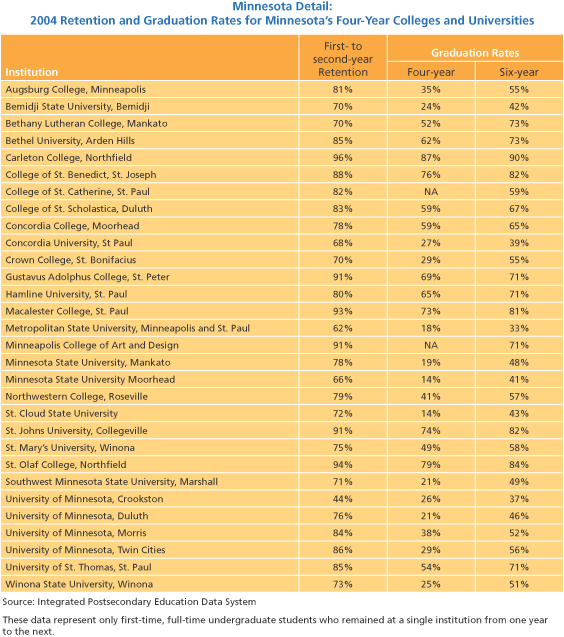
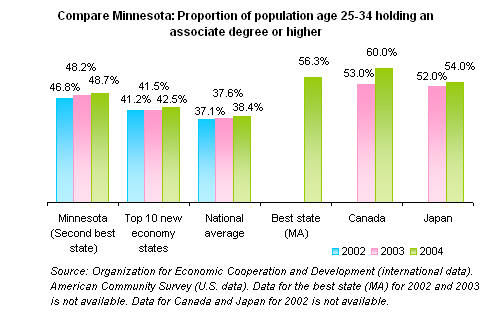
 parameters. Net college prices remain a concern for students from families
with the lowest income levels. Middle-income families pay the highest share
of their income on higher education. The Office of
Higher Education must continue to identify new measures of choice and access
and provide this information
to policymakers.
parameters. Net college prices remain a concern for students from families
with the lowest income levels. Middle-income families pay the highest share
of their income on higher education. The Office of
Higher Education must continue to identify new measures of choice and access
and provide this information
to policymakers.
